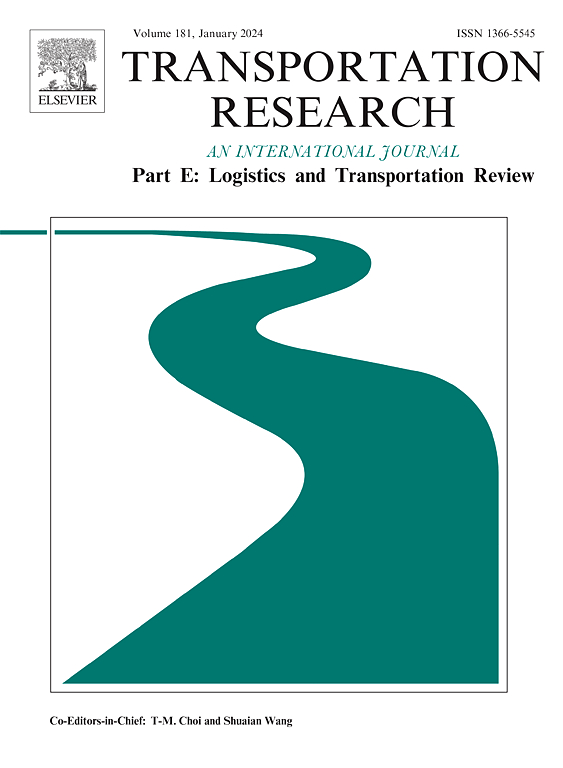A decomposable multi-fusion spatio-temporal marine traffic flow forecasting algorithm: Taking the North Sea and Baltic Sea region as an example
IF 8.8
1区 工程技术
Q1 ECONOMICS
Transportation Research Part E-Logistics and Transportation Review
Pub Date : 2025-08-05
DOI:10.1016/j.tre.2025.104340
引用次数: 0
Abstract
Maritime transportation, which is responsible for handling over 80% of global trade, is integral to the international supply chain. As global trade continues to expand, the management of marine traffic has become crucial for improving logistics efficiency. Precise and accurate marine traffic flow (MTF) prediction is essential for optimizing shipping routes, reducing transit times, and improving overall supply chain effectiveness. AIS equipment is now mandatory on vessels, transmitting static data such as the vessel’s identification code and flag state, along with dynamic data including latitude, longitude, speed and heading. High-frequency and comprehensive AIS data enables more accurate predictions of maritime traffic flow. In this paper, we propose an end-to-end MTF prediction framework utilizing AIS data as the primary source. The algorithm encompasses three critical steps: data preprocessing, marine traffic network extraction, and maritime traffic flow prediction. This comprehensive approach ensures more accurate predictions of the maritime traffic flow. In the marine traffic network extraction process, we distinguish nodes by categorizing AIS data feature points into mooring points and waypoints to obtain a more accurate identification. We then introduce a Decomposable Multi-fusion Spatio-temporal Network (DMFSTN) to enhance the accuracy of maritime traffic flow predictions. Existing approaches do not solve the relationship between static and dynamic features well. At the same time, the often-used serialized extraction of spatial and temporal features tends to overlook fine-grained spatio-temporal dependence features. To address these issues, our DMFSTN model integrates temporal and spatial features and leverages dynamic and static spatial relationships for more precise MTF predictions. Additionally, our model also decomposes marine flow data into trend and seasonal components, offering insights into underlying patterns. As a case study, we apply our model to analyze MTF of the North Sea and Baltic Sea region using data provided by the Danish Maritime Administration. Extensive comparative and ablation experiments in this dataset demonstrate the effectiveness of our model.
一种可分解的多融合时空海上交通流预测算法——以北海和波罗的海地区为例
海上运输占全球贸易的80%以上,是国际供应链的重要组成部分。随着全球贸易的不断扩大,海上交通管理已成为提高物流效率的关键。精确和准确的海上交通流量(MTF)预测对于优化航线、缩短运输时间和提高整体供应链效率至关重要。AIS设备现在是船舶上的强制性设备,传输静态数据,如船舶的识别码和船旗国,以及动态数据,包括纬度、经度、速度和航向。高频和全面的AIS数据可以更准确地预测海上交通流量。在本文中,我们提出了一个端到端的MTF预测框架,利用AIS数据作为主要来源。该算法包括三个关键步骤:数据预处理、海上交通网络提取和海上交通流预测。这种全面的方法确保了对海上交通流量的更准确预测。在海上交通网络提取过程中,我们通过将AIS数据特征点分类为系泊点和航路点来区分节点,从而获得更准确的识别。然后,我们引入了可分解的多融合时空网络(DMFSTN)来提高海上交通流预测的准确性。现有的方法不能很好地解决静态特征和动态特征之间的关系。同时,常用的时序特征提取往往忽略了细粒度的时空依赖特征。为了解决这些问题,我们的DMFSTN模型集成了时间和空间特征,并利用动态和静态空间关系进行更精确的MTF预测。此外,我们的模型还将海洋流量数据分解为趋势和季节成分,从而提供对潜在模式的见解。作为案例研究,我们使用丹麦海事局提供的数据,将我们的模型应用于北海和波罗的海地区的MTF分析。该数据集的大量对比和消融实验证明了我们模型的有效性。
本文章由计算机程序翻译,如有差异,请以英文原文为准。
求助全文
约1分钟内获得全文
求助全文
来源期刊
CiteScore
16.20
自引率
16.00%
发文量
285
审稿时长
62 days
期刊介绍:
Transportation Research Part E: Logistics and Transportation Review is a reputable journal that publishes high-quality articles covering a wide range of topics in the field of logistics and transportation research. The journal welcomes submissions on various subjects, including transport economics, transport infrastructure and investment appraisal, evaluation of public policies related to transportation, empirical and analytical studies of logistics management practices and performance, logistics and operations models, and logistics and supply chain management.
Part E aims to provide informative and well-researched articles that contribute to the understanding and advancement of the field. The content of the journal is complementary to other prestigious journals in transportation research, such as Transportation Research Part A: Policy and Practice, Part B: Methodological, Part C: Emerging Technologies, Part D: Transport and Environment, and Part F: Traffic Psychology and Behaviour. Together, these journals form a comprehensive and cohesive reference for current research in transportation science.

 求助内容:
求助内容: 应助结果提醒方式:
应助结果提醒方式:


